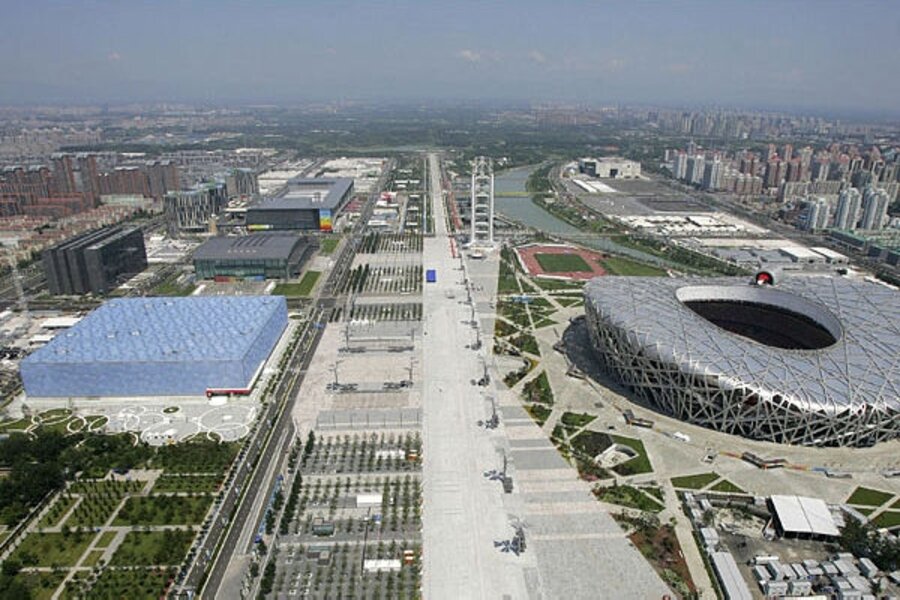Study: China's Olympic effort to curb smog had little effect
Loading...
Take a deep breath, click your heels three times, and repeat after me: "There's no place for smog. There's no place for smog. There's no place...."
Unfortunately, that's apparently about as effective a pollution-control technique as the measures China implemented for the 2008 Summer Olympics, if a new study is any indication. The Chinese government made Herculean efforts to ensure that the air quality in Beijing during the 2008 summer Games would meet World Health Organization standards. Colleague Peter Ford wrote about those efforts at the time.
Beijing's effort wasn't fruitless. The study notes that during the last three months of 2008, concentrations of the largest of the two particles types researchers measured – particles 10 microns across – dropped by 9 to 27 percent compared with the same period in 2007. The team attributes the decline to tighter controls on sources of pollution and perhaps the economic downturn.
But for all the hard work, Beijing's air quality violated WHO guidelines from 81 to 100 percent of the time, depending on which of two pollution-particle sizes you choose (either size is unpleasant).
The study appears in a recent issue of Environmental Science and Technology. A team of scientists from Oregon State University and Peking University in Beijing made the measurements.
The levels the team measured at Peking University were consistently 30 percent higher than official government readings – something the team attributes to different approaches to measuring. In addition, the university is located in a residential part of the city. Both sets of data tracked well when it came to overall trends, however.
China shut down factories, slashed the number of cars on the road, and took other extreme measures. The team found that while air quality measurably improved during the Olympics, favorable weather did more to clear the air than did explicit mitigation measures.
During a phone chat, one of the OSU scientists, Staci Simonich, notes that Beijing's experience reinforces two important messages:
1. If you want to reduce pollution in one spot, you'd better check wind direction and the levels of pollution in the air masses moving toward you.
"What we found in our study is that the region south of Beijing contributed greatly to the particulate-matter air pollution in Beijing," Dr. Simonich says. "Great efforts can be undertaken to try to clean up a certain city. But if your neighbor, or neighboring country, isn't making a similar effort and has large sources, then your neighbor's pollution can influence where you are."
It's a point scientists have made in other regions. For instance, US government scientists have looked at air pollution in southeastern cities like Atlanta and Nashville and found that the city could shut down every car, bus, truck, dry cleaner, and other sources of the ingredients for urban smog and still violate air-quality standards on certain summer days.
Why? Because coal-fired plants upwind send one class of smog precursor billowing over woodlands surrounding the metropolitan area. That precursor mixes with naturally occurring hydrocarbons that trees give off, and, presto: ozone pollution.
2. The results are a reminder that many people in developing countries breathe atrocious air on a daily basis. "A large percentage of the world's population is living in regions with high pollution – where particular-matter concentrations exceed World Health Organization guidelines," Simonich says.
The team also compared Beijing's air quality with that of cities hosting other recent summer Games. Here's how they ranked. Concentrations are given for 10-micron particles and expressed as micrograms per cubic meter. The WHO guideline for safe daily concentrations is 50. The percent change is based on levels compared with the month prior to the games:
City Avg. Concentrations; % change for Olympic Games
Beijing 2008: 82.4/53.7*; - 40
Athens 2004: 44.3; - 9
Sydney 2000: 23.7; + 72
Atlanta 1996: 28.1; - 29
*OSU-PKU/Beijing gov't; city's percent change based on OSU-PKU figures





